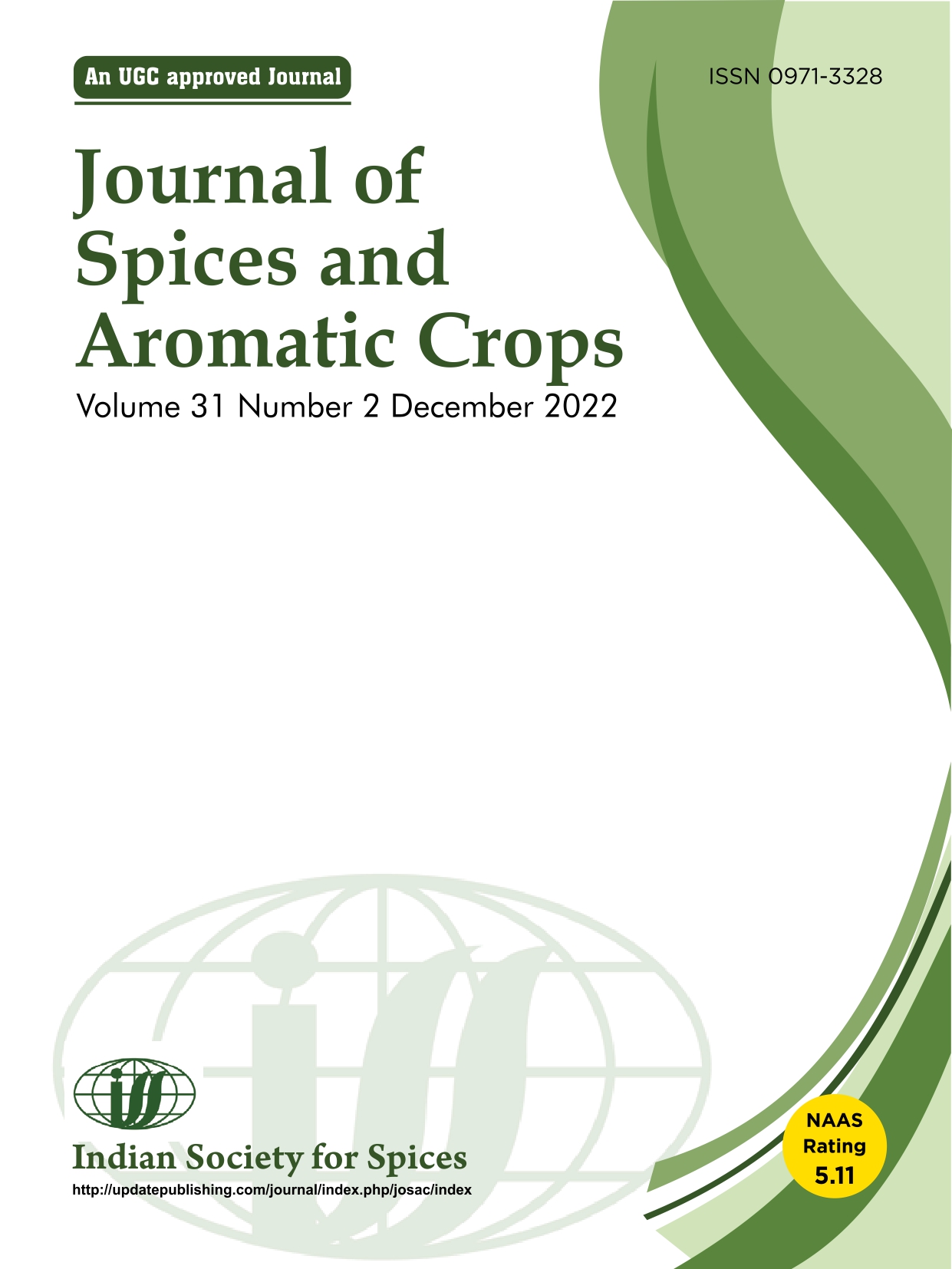Performance of Chilli (Capsicum annuum L.) hybrids for yield and quality traits
Chilli hybrids for yield and quality
DOI:
https://doi.org/10.25081/josac.2022.v31.i2.7701Keywords:
Capsicum annuum, performance, yield, Capsaicin, oleoresinAbstract
Twenty-eight F1 combinations of chilli (Capsicum annuum L.) obtained from half-diallel cross along with eight diverse parents were evaluated in a field study to elucidate the information on the extent of mean performance of various horticultural traits. The analysis revealed that all the genotypes possessed wide spectrum of variability and showed significant differences for parents and hybrids for the traits studied. For parents UHF CHI 13 (216.20), UHF CHI 15 (193.80), UHF CHI 5 (139.00) and for hybrids H1 (182.60), H9 (181.40) and H7 (172.80) hold highest fruit count per plant. The parents UHF CHI 5 (1047.13 g), UHF CHI 15 (949.62 g) and UHF CHI 7 (912.61 g) and cross combinations H17 (1535.10 g), H8 (1320.00), H6 (1229.76) and H18 (967.60) recorded the high ripe fruit yield per plant. As for earliness, parents UHF CHI 5 (43.33), UHF CHI 11 (45.00), UHF CHI 7 (45.33) and hybrids H27 (42.67), H26 (43.00) and UH28 (43.00) took minimum days for flowering. For pungency UHF CHI 12 (0.28%), UHF CHI 13 (0.26%), DKC-8 (0.24%) and H23 (0.33%), H5 (0.31%), H26 (0.26%) recorded high capsaicin content.
Downloads
References
Anonymous 2021 Indian Export Statistics. Agricultural and Processed Food Products Export Development Authority, Ministry of Commerce and Industry, Government of India, Gurgaon.
Anonymous 2021 Indian Horticulture Database. National Horticulture Board, Ministry of Agriculture, Government of India, Gurgaon.
Bosland P W & Votava E J 2012 Peppers Vegetable and Spice Capsicums 2nd Edition. CABI, Noseworthy Way Wallingford Oxford Shire, USA.
Gogoi D & Gautam B P 2002 Variability, heritability and genetic advance in chilli (Capsicum spp.). Agricultural Science Digest. (22): 102–104.
Janaki M, Naidu L N, Ramana C V & Rao M P 2015 Assessment of genetic variability, heritability and genetic advance for quantitative traits in chilli (Capsicum annuum L.). The Bioscan. 10: 729–733.
Jyothi K U, Kumari S S & Ramana C V 2011 Variability studies in chilli (Capsicum annuum L.) with reference to yield attributes. J. Hortic Sci. 6(2): 133–135.
Kadwey S, Dadiga A & Prajapati S 2015 Genotypes performance and genetic variability studies in Hot Chilli (Capsicum annum L.). Indian J. Agric Res. 50: 56–60.
Kumar R L, Sridevi O, Kage U K, Salimath P M, Madalageri D & Natikar P 2014 Heterosis Studies in chilli (Capsicum annuum L.). Int. J. Hortic. 4: 40–43.
Mamatha A, Devaraju & Premchand U 2017 Performance of chilli genotypes for growth and yield attributing traits under hill zone of karnataka. Environment & Ecology. 35(3B): 2165–2170.
Minz R R, Kurrey VK, Collis J P & Rajwat K S 2017 Selection parameters of chilli (capsicum annuum L.) genotypes for yield and related traits. J. Plant Dev Sci. 9(1): 141–144.
Nabeela K, Krishnakumary K & Indira P 2017 Variability studies in chilli for horticultural traits. J. Trop. Agric. 55(1): 87–90.
Nagaraja C, Gokulakrishnan J & Ramakrishna S 2016 Magnitude of Heterosis for quantitative characters in chilli (Capsicum annuum L.) in multi-location trials. Plant Archives 16(2): 607–616.
Pandey J, Singh J, Verma A, Singh A K, Rai M & Kumar S 2008 Evaluation of chilli (Capsicum annuum L) genotypes for some quality traits. J. Food Sci. Technol. 45: 463–465.
Pandiyaraj P, Saraladevi D, Juliet Hepziba S & Das A 2017 Genetic variability, heritability and genetic advance for quantitative and qualitative traits in chilli (Capsicum annuum L.). Int. J. Agric. Sci. 9(14): 4081–4083.
Panse V G & Sukhatme P V 1985 Statistical methods for agricultural workers. Indian Council of Agricultural Research, New Delhi. 2(7): 87– 89.
Patel K L, Sarnaik D A, Sharma D & Mehta N 2014 Genetic variability studies in chilli (Capsicum annuum L.). J. Plant Dev Sci. 6(2): 321–324.
Pramanik K C & Srivastava S K 2013 Role of capsaicin in cancer prevention. In: S.K. Srivastava (ed.), Role of Capsaicin in Oxidative Stress and Cancer. Springer, Singapore. pp. 1–18.
Reddy M K, Srivastava A, Kumar S, Kumar R, Chawda N, Ebert A W & Vishwakarma M 2014 Chilli (Capsicum annuum L.) breeding in India: An Overview. SABRAO J. Breed. Genet. 46(2): 160–173.
Rohini N & Lakshmanan V 2017 Heterotic expression for dry pod yield and its components in chilli (capsicum annuum var. annuum). J. Anim Plant Sci. 27(1): 207–218.
Salvador M H 2002 Genetic resources of chilli (Capsicum annuum L.) in Mexico. Proceedings of the 16th Int. Pepper Conf., Tampico, Tamaulipas, Mexico, November Pp.10–12.
Sharma A, Swain D & Sekhon B S 2017 Breeding strategies based on diversity analysis in advance breeding lines of chilli (Capsicum annuum var. annuum L.). Electronic Journal of Plant Breeding. 8: 1247–1257.
Shetty A A, Magadum S & Managanvi K 2013 Vegetables as Sources of Antioxidants. J. Food Nutr. Diso. 2:1.
Singh Y, Sharma M & Sharma A 2014 Genetic Variation, Association of Characters, and their direct and indirect contributions for improvement in Chilli peppers. Int. J. Veg. Sci. 15(4): 340–368.
Wani K P, Ahmed N, Wani S A, Jabeen N, Mushtaq F, Afroza B, Singh P K & Hussain K 2013 Comparative performance of various chilli genotypes under temperate conditions of kashmir. SKUAST J. Res. 15: 117–122.
Published
How to Cite
Issue
Section
Copyright (c) 2022 Vinay Verma, Amit Vikram, Yash Pal Sharma, Ramesh K Bhardwaj, Rajesh K Dogra, Meenu Gupta, Shalini Singh

This work is licensed under a Creative Commons Attribution-NonCommercial-NoDerivatives 4.0 International License.






 .
.